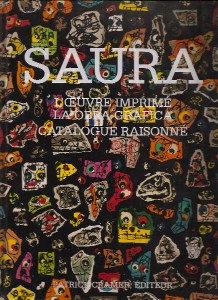
Since 1996 we have been buying and selling fine used books, from vintage collectibles to signed first editions. Search and browse our inventory online and follow "The Mouse" for updates.
Click to Search
our inventory by Author, Title, Publisher, and Keyword at AbeBooks.com.
Click to Browse
our inventory at AbeBooks.com.
Phone: 631.725.8654
Mailing: PO Box 943,
Sag Harbor, NY 11963
blackcatbooks@yahoo.com
Antonio Saura (1930–1998) began painting and writing in 1947 in Madrid while suffering from tuberculosis, having already been confined to his bed for five years. He developed a highly personal style, creating numerous drawings and paintings with a dreamlike surrealist character that most often represent imaginary landscapes, employing a flat smooth treatment that offers a rich palette of colours.
In Paris he Started using the technique of scraping, adopted a gestural style and a radically abstract type of painting, still very colourful and boasting an organic, aleatory design. He began painting by occupying the space of the canvas in several very distinct ways, creating formal structures that now very much bear his distinctive stamp and which he continued to develop endlessly. Then we see the use of forms that will soon become archetypes of the female body or the human figure. These two fundamental themes are to take up the greater part of his work. Starting in 1956 Saura tackles the register of what will prove to be his great series, Ladies, Nudes, Self-portraits, Shrouds and Crucifixions, which he paints on both canvas and paper. In Madrid founds the El Pasogroup in 1957 and serves as its director until it breaks up in 1960. Meets Michel Tapié. First solo exhibition at the Rodolphe Stadler Gallery in Paris, where he will regularly show throughout his life. Stadler will later introduce him to Otto van de Loo in Munich and Pierre Matisse in New York, both of whom will exhibit his work and represent the artist.
Now limiting his palette to blacks, greys and browns. Asserts a personal style that is independent of the movements and trends of his generation. His work follows in the tradition of Velasquez and Goya. It soon enters the major museums. Starting in 1959 begins creating what will prove to be a prolific body of works in print, illustrating in an original way numerous books like Cervantes’s Don Quijote, Orwell’s 1984, Nöstlinger’s adaptation of Pinocchio, Kafka’s Tagebücher, Quevedo’s Three visions, and many others. In 1960 begins practicing sculpture, creating works made of welded metal elements which represent the human figure, characters and crucifixions.
In 1967 settles permanently in Paris, joins the opposition to the Franco dictatorship and takes part in numerous debates and controversies in the fields of politics, aesthetics and artistic creation. Broadens his thematic and pictorial register. Along with his Femmefauteuil (literally Womanarmchair), the series Imaginary Portraits, Goya’s Dog and Imaginary Portraits of Goya begin to take shape.In 1971 abandons painting on canvas (which he will take up again in 1979) to devote himself to writing, drawing and painting on paper. In 1977 begins publishing his writings, creates several stage designs for the theatre, ballet and opera. From 1983 to his premature death, revisits and brilliantly develops all of his themes and figures, and produces perhaps the best work in his entire oeuvre.
Description: Hard bound with glassine dust jacket in publishers cardboard slipcase, as issued. Signed by the publisher Patrick Cramer. A very nice copy, bright and clean. This catalogue raisonné comprises the description and reproduction of 632 engravings, lithographs and silk-screen prints by the artist. When a piece by Saura is an integral part of a book, album or catalogue, the work is also described. A chronological presentation of the prints is followed by a chronological index, an alphabetical index and an index of the authors of the books illustrated by Saura. The catalogue concludes with a postface that addresses the links Antonio Saura maintained with the world of publishing and book illustration. Save for the specifications of the prints, which are written in French, all texts are given in French and Spanish.
Inventory # 14214
SOLD
Antonio Saura : L’oeuvre Imprime La Obra Grafica
Cramer, Patrick
Publisher: Patrick Cramer
Publication Date: 2000
Binding: Hard Cover
Book Condition: Near Fine
Dust Jacket Condition: Near Fine
Signed: Signed by Publisher
· Category: Sold ·

